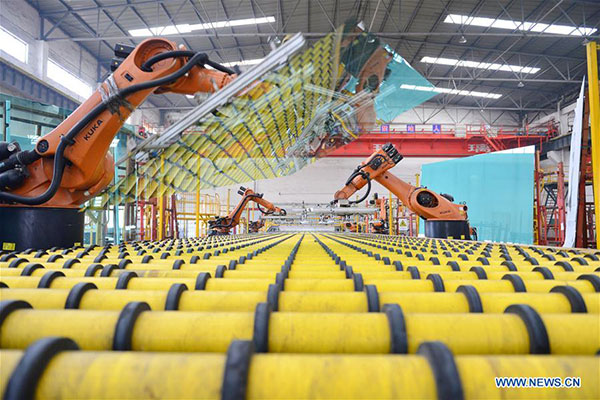Economic indicators for first half released
 |
|
Photo taken on March 26, 2017 shows a glass production line of an enterprise in Shahe city, North China's Hebei province.[Photo/Xinhua] |
China released a string of economic indicators for the first half of the year on Monday. Data showed China's economy expanded at a faster-than-expected 6.9 percent year-on-year in the first six months of 2017. Indicators related to people's livelihoods, such as jobs, income and CPI were also bright spots. Particularly, the growth of resident income exceeded GDP growth. Experts predicted that China's economy is set to remain stable during the second half of 2017.
Better-than-expected GDP data
China's gross domestic product rose 6.9 percent year-on-year to about 38.15 trillion yuan ($5.6 trillion) in the first half of 2017, data from the National Bureau of Statistics showed.
In the second quarter, China's GDP held steady, posting a rise of 6.9 percent year-on-year, flat from the first quarter and slightly higher than the previous market consensus of 6.8 percent.
Zhao Xijun, deputy dean of the School of Finance at Renmin University, attributed the strong GDP data to steady or increase of some key indicators such as consumption, imports and exports, private investment against the backdrop of supply-side structural reform and demand recovery at home and abroad.
China's retail sales of consumer goods grew 10.4 percent year-on-year in the first half of the year to 17.24 trillion yuan. This pace was slightly faster than the 10 percent for the first quarter, the National Bureau of Statistics said.
Exports in yuan-denominated terms rose 15 percent year-on-year in the first half of this year while imports increased 25.7 percent, customs data showed.
Fixed-asset investment grew 8.6 percent year-on-year in the first half, while private sector investment rose 7.2 percent to 17.02 trillion yuan, accounting for 60.7 percent of the total, according to the National Bureau of Statistics.
Resident income growth exceeds GDP growth
China's average per capita disposable income grew 8.8 percent year-on-year to 12,932 yuan in the first six months of the year, data from the National Bureau of Statistics showed. Deducting inflation, the growth was 7.3 percent, exceeding the country's GDP growth of 6.9 percent from January to June.
Strong income growth and lifestyle changes in previous years have helped boost China's consumer spending amid the government's efforts to shift the economy toward a growth model that draws strength from consumption, the service sector and innovation.
Xu Hongcai, an economist with the China Center for International Economic Exchanges, told China News Service website that the stable job market laid a solid foundation for income growth. Meanwhile, the government encouraged mass entrepreneurship and innovation, motivating new engines for economic growth.
Completing two-thirds of annual job goal
The crucial job market remained stable, with 7.35 million jobs created in urban areas in the first half of this year, 180,000 more than last year, according to the National Bureau of Statistics. That means China has already fulfilled 66.8 percent of its official goal of creating 11 million new jobs this year.
Meanwhile, both the national urban surveyed unemployment rate and the surveyed unemployment rate in 31 major Chinese cities stayed below 5 percent in June.
The government's promotion of mass entrepreneurship and innovation, an expanding service sector and the upgrade of the manufacturing sector offered strong support for employment, Zhao said.
Consumer inflation holds steady
China's consumer price index (CPI), a main gauge of inflation, rose 1.4 percent on average in the first half of the year. Excluding volatile food and energy prices, the core CPI increased 2.1 percent year-on-year.
Steady price data, well under the government's target of 3 percent, reinforced views on stabilization in the world's second-largest economy.
The monetary factor has a stable effect on prices as the central bank continues with prudent and neutral policies, Zhao said. Meanwhile, as market supply and demand remained stable and imported inflation factors lessen, Zhao said CPI may still remain low in the second half of the year.
Xinhua contributed to this story.















